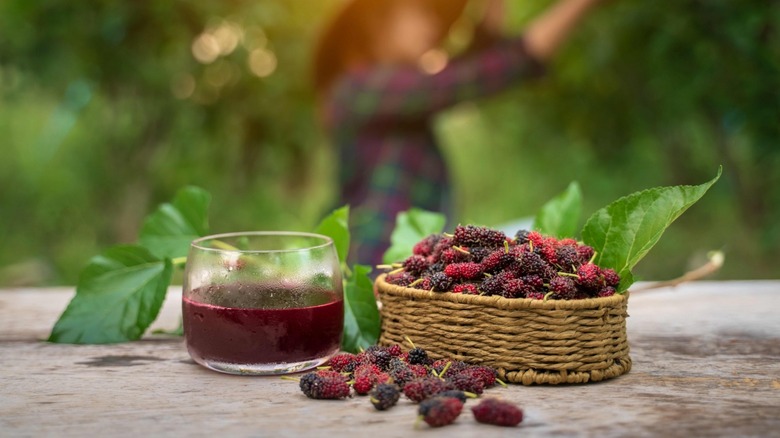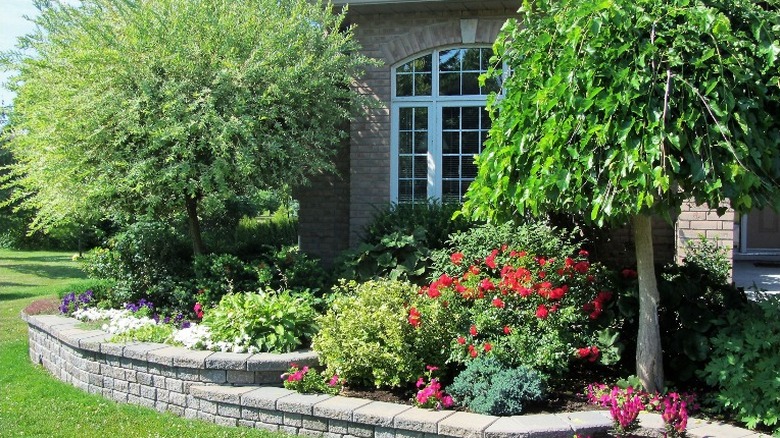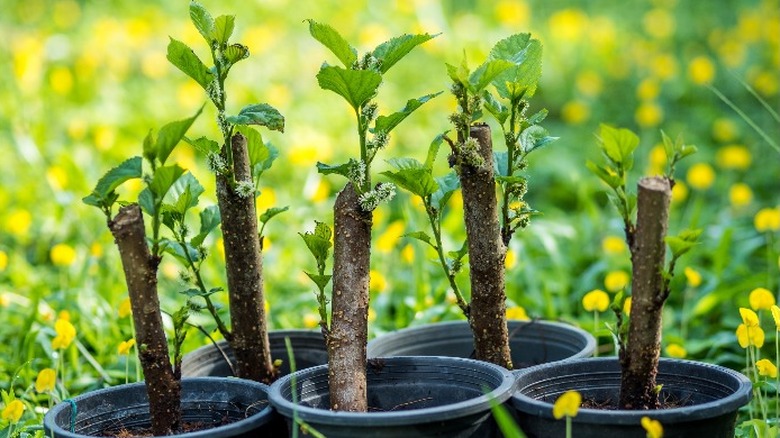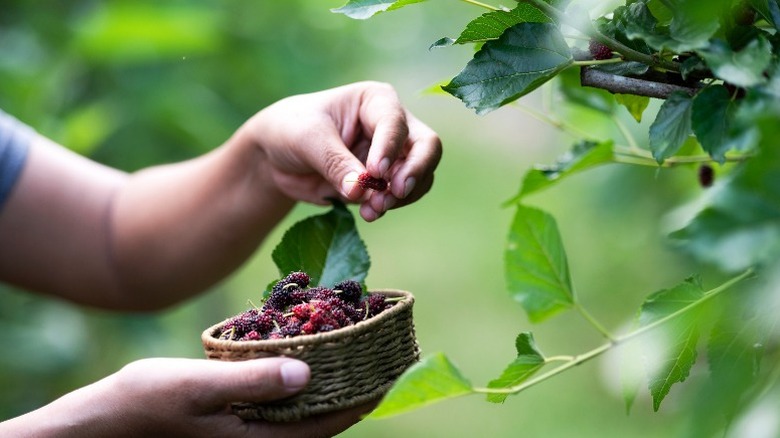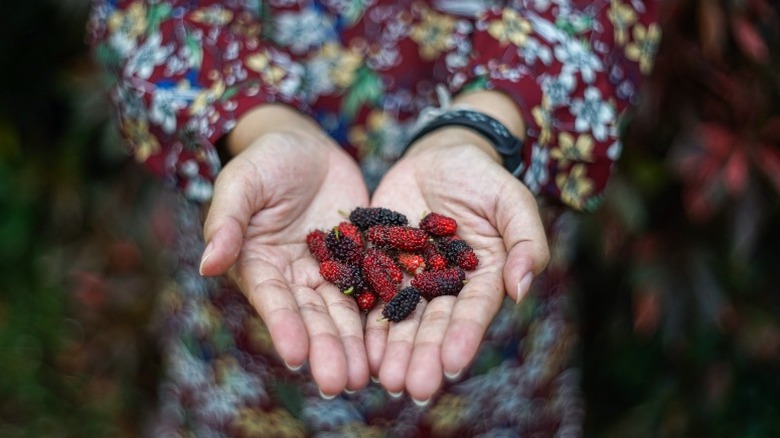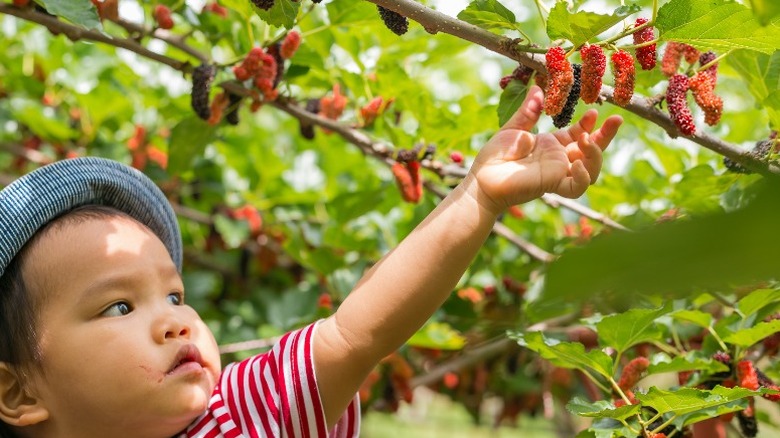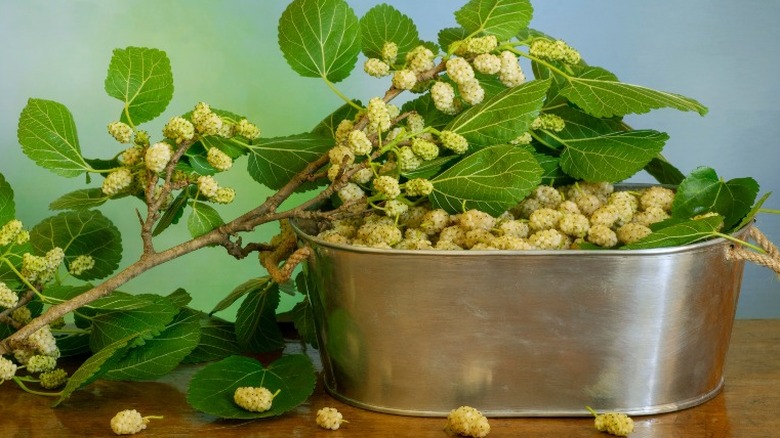How To Grow And Take Care Of Mulberry Trees
There are several different species of the mulberry tree, all members of the genus Morus. These fast-growing and iconic fruit trees are beloved by children and birds alike, who have been known to gorge on the bright berries and leave juice stains all around. In addition, white mulberry leaves are the favorite food of silkworms. As The Spruce noted, the attempt to start silk production in North America is the reason why white mulberry trees were initially introduced to American soil. However, the tree's prolific germination means that many now consider the white mulberry an invasive species. These shrubs grow outstandingly well in the hardiness zones 5 to 9 and reseed without much effort, producing more than a few trees without needing special thriving conditions.
As HGTV explained, mulberry trees have leaf shapes that can vary even on the same tree. In addition, factors such as the level of shade and moisture will cause the tree to adapt its leaves. This adaptability — along with an outstanding ability to spread — means that mulberry trees are typically considered difficult to control rather than difficult to grow. This makes them an excellent first fruit tree to consider for your garden.
How to use mulberry trees in your garden
Mulberry trees are prolific growers, fruiters, and spreaders. For these reasons, Gardeners Path suggested growing your mulberry tree in a space that you want to become an established woody area in a few years. They also caution against planting them too close to underground utilities such as septic tanks and electric cables. Mulberry branches spread wide, and their root systems go just as far underground, which have been known to crack pavements (as well as tank linings!).
Additionally, while their fruit might be delicious and brightly colored, the pigment will be a lot less appealing if it ruins your pristine laundry every time the tree is in fruit. Planting them too close to any expensive garden furniture is to be avoided for the same reasons. The powerful coloration of mulberries also survives being digested by birds, as Dave's Garden pointed out from personal experience. This could mean that the slightly out of the way spot you are thinking of for your mulberry tree is probably not far enough away!
How to grow mulberry trees
As long as you are located in a zone that will not kill them with frost, growing mulberry trees is very easy. Gardening Know How makes the point that while mulberry trees favor full sunlight and warm, well-draining, and loamy soil, they will tolerate partial shade and a wide range of soil types. Seeds can and do germinate from the fruit into full-fledged mulberry trees. However, as myGarden pointed out, trees grown from the fruit can take many years to bear fruit of their own.
Like other fruit trees, the best results tend to come from propagating cuttings. These cuttings should be made in the summer or fall and planted in the fall or early spring. This gives a young tree the best chance to develop a root system that can support it throughout the following winter. For the same reason, if the soil you're planting into is overly dense, remember to loosen it up and add some fertilizer before planting to give the roots a chance to spread out.
How to care for a mulberry tree
The Green Pinky clarifies that the priority of anyone caring for a young mulberry bush is to protect the roots from the cold, especially for the first few years. At the beginning of the winter, spread insulating mulch around the tree's base for at least 3 feet in all directions to ensure the root core doesn't freeze. Mulberries will do best in full sunlight and, when first planted, will need regular watering. However, Epic Gardening didn't call the mulberry "the easiest berry to grow" for nothing: Once the trees are safely established, they only require annual pruning and infrequent watering. In fact, you can even skip the pruning if your goal isn't to maximize fruit production.
You can fertilize mulberry trees, but it's not recommended in the first year. A single application of a well-balanced 10-10-10 fertilizer is all it needs in the following years; the best time to do this is in the late winter or early spring. Furthermore, around 1 inch of water per week is enough for mulberries; for most trees, that will come from rain and groundwater, so you merely need to take care to establish its roots, and then only water during arid periods.
Mulberry tree varieties
According to Wild Abundance, there are 68 different species of the mulberry tree. However, only three or four species form the bulk of mulberry trees grown by gardeners. Growing Mulberry mentions a few popular varieties:
- White mulberry (Morus alba) is the most invasive and transplanted species of the mulberry tree. It's integral in silk production, loves direct sun, and the fruits it produces can be white, black, or red.
- Red mulberry (Morus rubra) can handle shadier conditions than white mulberry trees. They are native to North America and are being hybridized and out-competed by the Morus alba, so it is worth strong consideration by ethical gardeners.
- Black mulberry (Morus nigra) prefers drier, more alkaline, and Mediterranean-like climates. Black mulberry is the slowest growing species, but many berry lovers prize the flavor of this fruit above all others.
- Long mulberry, aka Pakistan/Himalayan mulberry (Morus macroura) produces strikingly large fruit, up to 4-5 inches in length. While it prefers very warm climates (USDA Zones 9-10), it is the most disease-resistant mulberry variety.
- Fruitless mulberry (Morus alba "Fruitless") is a cultivar of the M. alba that has been bred for the stain-averse gardener. As the name suggests, it doesn't bear fruit but is an excellent choice for a shade tree per Gardening Know How.
Are mulberry trees toxic?
According to the Lady Bird Johnson Wildflower Center, the sap and unripe fruit of the mulberry tree are considered mildly toxic. The leaves also contain the same compounds and latexes that can irritate the skin or digestive system. These irritations are reported by Eat the Weeds to cause gastrointestinal distress and, in some cases, mild hallucinations. However, white mulberry leaf tea is a popular drink in some Asian cultures because its toxicity goes away rapidly with heat, Healthline reports.
According to a study published by the National Library of Medicine, it also has the potential to help manage cardiometabolic issues such as type 2 diabetes. So remember, if you're eating anything other than the ripened fruit, you should always cook your mulberry products thoroughly. In addition, the ASPCA lists mulberry trees as non-toxic for dogs, cats, and horses, so animal lovers can rest safe in the knowledge that their furry friends will be in no danger from the addition of a mulberry tree in their garden.
How to repot a mulberry tree
Mulberry trees are not a great choice for patio or container plants, given their reputation for mess and stains. However, Balcony Garden Web did have some tips for growing mulberry trees in pots. As previously noted, mulberry trees are root-focused growers. If you are growing the trees in open soil, this is simply something to be aware of in terms of avoiding underground obstacles. When considering growing mulberry trees in pots, it is vital to place the tree in a small container, to begin with. If you give mulberry trees the option of growing fruits or roots, they will invariably choose roots. By keeping the trees in smaller containers until they get rootbound, you force the tree to focus its energy on leaves, flowers, and fruit production.
Mulberry trees prefer well-draining soil, and if grown in pots, Gardening Bank even suggested using a soil-less potting mix. If you want to relocate the tree and change its pot, move the shrub to the new location a few days before repotting. This will limit how many shocks to the system the tree is dealing with at a time. Once a new pot is prepared, thoroughly soak the soil in the original container to make moving the roots as easy as possible. Next, relocate the tree to the new place, planting deep enough to cover the roots completely, then water it thoroughly. Remember that the new pot shouldn't be too much larger than the original.
